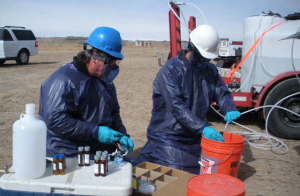The Marcellus Shale Documentary Project
October 12, 2012History of Oil and Gas Well Abandonment in NYS
October 18, 2012By Scott K. Johnson, Ars Technica, October 11, 2012
 In December of last year, Ars reported on a major EPA study in Pavillion, Wyoming that concluded hydraulic fracking operations there had contaminated the groundwater aquifer. While there wasn’t a clear link to contamination detected in some shallow private water wells, EPA believed the deeper contamination was very likely related to fracking. This determination came primarily from two deep monitoring wells that EPA had installed for the investigation.
In December of last year, Ars reported on a major EPA study in Pavillion, Wyoming that concluded hydraulic fracking operations there had contaminated the groundwater aquifer. While there wasn’t a clear link to contamination detected in some shallow private water wells, EPA believed the deeper contamination was very likely related to fracking. This determination came primarily from two deep monitoring wells that EPA had installed for the investigation.
Encana, the gas exploration company that owned the natural gas wells, disagreed vehemently. They asserted that EPA had drilled monitoring wells into a zone where gas was naturally present. As for the other compounds EPA detected in the wells, which were known to be components of fluids used during fracking, Encana said these were likely introduced into the aquifer during the drilling of the monitoring wells. EPA had foreseen this objection, and went to great lengths to avoid contaminating the monitoring wells. But Encana was not satisfied.
In the end, the EPA, the United States Geological Survey (USGS), the Wyoming Geological Survey, the Wyoming Department of Environmental Quality, the Wyoming Oil and Gas Conservation Commission, and the Wyoming Water Development Office met to discuss these objections. They decided that the EPA and USGS would carefully re-sample the deep monitoring wells to verify the results EPA had gotten previously.
The USGS released their data (carefully avoiding any interpretation or conclusions) a couple weeks ago, and the EPA’s report was made available Wednesday. Literally hundreds of samples were collected from the two deep monitoring wells (as well as several private wells that had previously been sampled) and submitted to a number of different laboratories. The analysis was extremely rigorous—testing multiple duplicate samples at separate labs with different techniques, etc.
Perhaps most importantly, for Encana’s objections, the samples were taken at multiple times during the pumping (or purging) of the well. Samples were taken early on, and then taken again (several times) later as the pumping continued. In addition, a number of geochemical properties were monitored continuously for changes during pumping, which would indicate differences between water in the well and water in the aquifer. If the contaminants were related to the materials used to install the well, you would expect to see them progressively diluted as water sitting in the well was replaced several times over with water from the aquifer.
No such effects were seen, and the results looked no different than the original samples presented in EPA’s report last December. This demonstrates a couple things: the concentrations are indeed representative of the groundwater in those locations, and the numbers they initially reported are accurate.
It’s important to note that while natural gas was once again detected in the nearby private water wells, no other contaminants were detected. So those wells may need to be vented to prevent explosive hazards in the homes, but there don’t appear to be any other health risks.
What comes next? Following a period for public comment, EPA’s report (along with the new data) will finally go to the peer-review committee that must look it over before it’s finalized. More information can be found on EPA’s project page for Pavillion.



